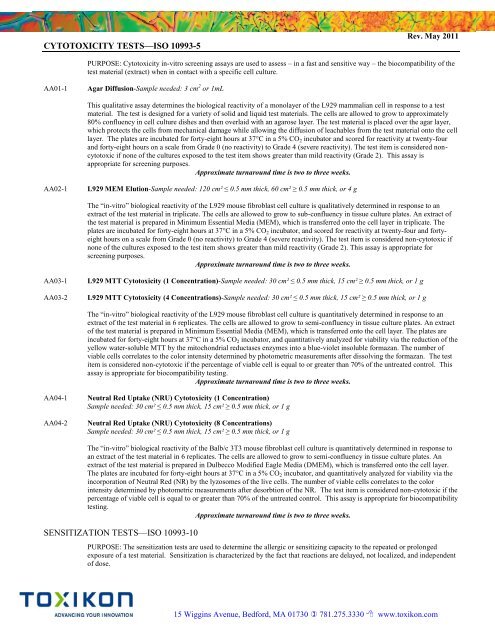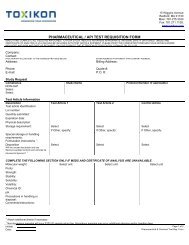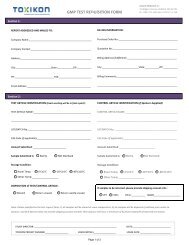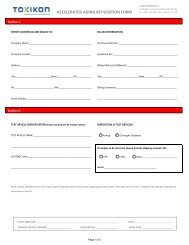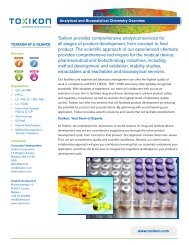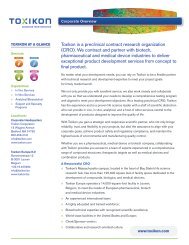Medical Device Testing Guide - Toxikon Corporation
Medical Device Testing Guide - Toxikon Corporation
Medical Device Testing Guide - Toxikon Corporation
You also want an ePaper? Increase the reach of your titles
YUMPU automatically turns print PDFs into web optimized ePapers that Google loves.
CYTOTOXICITY TESTS—ISO 10993-5<br />
Rev. May 2011<br />
PURPOSE: Cytotoxicity in-vitro screening assays are used to assess – in a fast and sensitive way – the biocompatibility of the<br />
test material (extract) when in contact with a specific cell culture.<br />
AA01-1<br />
Agar Diffusion-Sample needed: 3 cm 2 or 1mL<br />
This qualitative assay determines the biological reactivity of a monolayer of the L929 mammalian cell in response to a test<br />
material. The test is designed for a variety of solid and liquid test materials. The cells are allowed to grow to approximately<br />
80% confluency in cell culture dishes and then overlaid with an agarose layer. The test material is placed over the agar layer,<br />
which protects the cells from mechanical damage while allowing the diffusion of leachables from the test material onto the cell<br />
layer. The plates are incubated for forty-eight hours at 37°C in a 5% CO 2 incubator and scored for reactivity at twenty-four<br />
and forty-eight hours on a scale from Grade 0 (no reactivity) to Grade 4 (severe reactivity). The test item is considered noncytotoxic<br />
if none of the cultures exposed to the test item shows greater than mild reactivity (Grade 2). This assay is<br />
appropriate for screening purposes.<br />
Approximate turnaround time is two to three weeks.<br />
AA02-1<br />
L929 MEM Elution-Sample needed: 120 cm² ≤ 0.5 mm thick, 60 cm² ≥ 0.5 mm thick, or 4 g<br />
The ―in-vitro‖ biological reactivity of the L929 mouse fibroblast cell culture is qualitatively determined in response to an<br />
extract of the test material in triplicate. The cells are allowed to grow to sub-confluency in tissue culture plates. An extract of<br />
the test material is prepared in Minimum Essential Media (MEM), which is transferred onto the cell layer in triplicate. The<br />
plates are incubated for forty-eight hours at 37°C in a 5% CO 2 incubator, and scored for reactivity at twenty-four and fortyeight<br />
hours on a scale from Grade 0 (no reactivity) to Grade 4 (severe reactivity). The test item is considered non-cytotoxic if<br />
none of the cultures exposed to the test item shows greater than mild reactivity (Grade 2). This assay is appropriate for<br />
screening purposes.<br />
Approximate turnaround time is two to three weeks.<br />
AA03-1<br />
AA03-2<br />
L929 MTT Cytotoxicity (1 Concentration)-Sample needed: 30 cm² ≤ 0.5 mm thick, 15 cm² ≥ 0.5 mm thick, or 1 g<br />
L929 MTT Cytotoxicity (4 Concentrations)-Sample needed: 30 cm² ≤ 0.5 mm thick, 15 cm² ≥ 0.5 mm thick, or 1 g<br />
The ―in-vitro‖ biological reactivity of the L929 mouse fibroblast cell culture is quantitatively determined in response to an<br />
extract of the test material in 6 replicates. The cells are allowed to grow to semi-confluency in tissue culture plates. An extract<br />
of the test material is prepared in Minimum Essential Media (MEM), which is transferred onto the cell layer. The plates are<br />
incubated for forty-eight hours at 37°C in a 5% CO 2 incubator, and quantitatively analyzed for viability via the reduction of the<br />
yellow water-soluble MTT by the mitochondrial reductases enzymes into a blue-violet insoluble formazan. The number of<br />
viable cells correlates to the color intensity determined by photometric measurements after dissolving the formazan. The test<br />
item is considered non-cytotoxic if the percentage of viable cell is equal to or greater than 70% of the untreated control. This<br />
assay is appropriate for biocompatibility testing.<br />
Approximate turnaround time is two to three weeks.<br />
AA04-1<br />
AA04-2<br />
Neutral Red Uptake (NRU) Cytotoxicity (1 Concentration)<br />
Sample needed: 30 cm² ≤ 0.5 mm thick, 15 cm² ≥ 0.5 mm thick, or 1 g<br />
Neutral Red Uptake (NRU) Cytotoxicity (8 Concentrations)<br />
Sample needed: 30 cm² ≤ 0.5 mm thick, 15 cm² ≥ 0.5 mm thick, or 1 g<br />
The ―in-vitro‖ biological reactivity of the Balb/c 3T3 mouse fibroblast cell culture is quantitatively determined in response to<br />
an extract of the test material in 6 replicates. The cells are allowed to grow to semi-confluency in tissue culture plates. An<br />
extract of the test material is prepared in Dulbecco Modified Eagle Media (DMEM), which is transferred onto the cell layer.<br />
The plates are incubated for forty-eight hours at 37°C in a 5% CO 2 incubator, and quantitatively analyzed for viability via the<br />
incorporation of Neutral Red (NR) by the lyzosomes of the live cells. The number of viable cells correlates to the color<br />
intensity determined by photometric measurements after desorbtion of the NR. The test item is considered non-cytotoxic if the<br />
percentage of viable cell is equal to or greater than 70% of the untreated control. This assay is appropriate for biocompatibility<br />
testing.<br />
Approximate turnaround time is two to three weeks.<br />
SENSITIZATION TESTS—ISO 10993-10<br />
PURPOSE: The sensitization tests are used to determine the allergic or sensitizing capacity to the repeated or prolonged<br />
exposure of a test material. Sensitization is characterized by the fact that reactions are delayed, not localized, and independent<br />
of dose.<br />
15 Wiggins Avenue, Bedford, MA 01730 781.275.3330 www.toxikon.com


